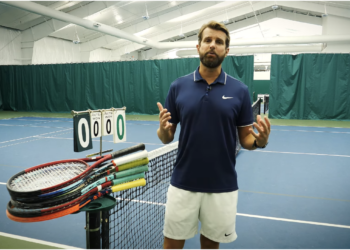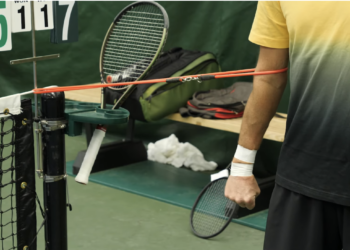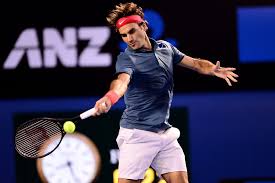Implement these 3 strategies to successfully return kick serves.
Hey guys, Nate and Scott, our buddy, Ryan. Today, we’re going to show you how to make sure your kick serve is actually kicking.
Hey internet, today we are showing you how to make your serve finally kick. Today’s instruction is a little bit more advanced. It’s for PlayYourCourt player at the rating of 80 and above. Today, helping us, showing us how to hit these massive-
Speaking of above.
Today, we have a tree that is helping us with the instruction. Current student, Ryan Charles, that is playing at George Mason University, Division I school.
And you thought we were going to teach you kick serves. We’re actually just going to tell you what he eats, so that you can do the same thing – Everything
and grow to be really, really tall. – He eats everything Yeah so today, guys, exciting stuff, a little bit more advanced, Scotty, tell us what are we talking about, What’s the difference here between a topspin serve and a kick serve?
For sure, there’s a lot of confusion here. I think a lot of us learn what they think is a kick serve and it’s actually a topspin serve. The difference between the two, a topspin serve, just like a top spin ground stroke, rolls end over end and doesn’t kick in any direction. A true kick serve, if you’re doing this correctly, a righty, for example, on the ad-court, not just bounces up, but up and out That’s why it calls- That’s why it’s called a kick serve ’cause it kicks up and out.
Yep, so guys, that’s going to be the big difference and we’re talking about two very, very different things, one that’s a collegiate level serve that goes all the way up the ranks to the ATPWTA that everybody has, and then ones that, you know, a little bit more accessible to the recreational player. We’re going to show you, right now we’re going to show you, progressions in exercises and the key concepts to get this ball to kick to get your to serve to the next level. Let’s jump right into it.
And don’t be scared if you’re not seven foot five, this will still work for you as well.
Okay guys, so we’re going to show you everything you need to develop this kick serve and we’re talking about that high performance kick serve, not just, you know, getting the ball to push up, really getting the ball to kick out but we’re not going to fool you into thinking that this happened overnight. Ryan’s worked really hard at this and really it’s conceptualizing it, it’s working through progressions, all right, and it’s even stuff that you’re doing outside of the tennis court, like off the tennis court in the gym that’s helping to improve this. All right so the very first thing we’re going to cover are the exercises. And the kettle bell is like one of my favorite here, alright If you can do a pulse-up- Right, my old coach used to call ’em throwin’ the bomb You know, um, kind of like football but the idea here is like if you’re not using your leg, right, it becomes more of like a tricep exercise but as soon as I incorporate my lower leg and firing the hip, right, Now I’m onto something, now I’m getting to where it makes a whole lot more sense to apply this to a kick serve.
We’re going to set this back behind him alright, and the important part here is that Ryan is going to isolate his upper body, his left side, okay? So what we’re focusing on is this rotational force so he’s going to drop back, he’s going to grab the kettle bell, he’s going to twist, and he’s going to push up and so what’s really important here is you can see the heel is off the ground, and he’s firing through the leg. Let’s do that one more time, careful with those knees, we want to make sure the knees are tracking in the same direction.
It’s taken him a long time to work up to seven pounds We had to borrow this today so no judgment out there. But so now that we have the kettle bell out of the way, we’re going to incorporate an exercise with throwing and this has to be accredited to uh, to Mark Kovacs, our good friend Will Hamilton with Fuzzy Yellow Balls has worked a lot with Mark Kovacs, who is the head of sports science with the USDA working with a lot of the Americans on tour, helping them with things just like improving the kick serve so in this exercise, same thing, working through that rotational force, loading that back leg, firing, and working through, all right, would be a little bit better if he isolated the left shoulder a little bit more, but definitely got some firing off the ground, okay? So, before he does it again, what I want you to pay attention to is the firing of the back hip and this is important because it’s the same thing like the way rocket works, right, we have to get this booster to where the leg is firing through the ground, right, and then that energy that is exchanged through the kinetic chain up through the hip, that hip getting rotational force through the hip and then getting shoulder over shoulder, is where he’s going to get all this massive power that makes the kick- the serve kick in the nature that it does. So one more time here. He fires up All right, pretty good. All right, so those are a couple exercises that are going to absolutely help you feel the rotation that you need ’cause I’m- we’re assuming, guys, that you’re out there at least, whether you’re 4-0, 4-5, or 5-0 you need more kick, you’ve got the basics, right, you’re getting spin all right now it’s getting it to kick. So now we’re going to show you how kind of the key elements on it but we’re going to backtrack it.
So maybe you don’t have that great of a kick serve, maybe you’re simply just rolling it in, we’re going to take it step by step now and show you every single element that makes this serve so great. All right so the first progression, guys, is we’re going to talk about the contact and what the racket needs to be doing to the ball. All right, now we’re not going to– we’re not going over every single detail This is assuming that you’re already working up the ball we’ll link another, um, video that we’ve done or like really understanding to help conceptualize it. Um, and that’s the little drill that I was just doing above my head, and a couple other things that we’ve worked on. We just want to go over a couple progressions. The one thing I will mention is when Ryan is tossing, you’ll notice- Ryan, if you’ll kind of start going through the motion. You’ll notice that Ryan tosses parallel to the base line. Right, his arm isn’t in front, and this is key here, all right, because not only is it getting the ball up above his head, it’s also helping with that hip rotation. All right guys so in the first one, what Ryan’s doing is he’s just focused on getting under the ball.
You can tell here that there’s no follow through, right, and you can see it’s like massive, massive height. Super trajectory, right? But here he’s just focusing– Go through that one more time, Ryan, with the racket moving, and getting up. So we’re getting this kind of arc up to the ball. All right, that is step one. You can tell, no problem finding the height. We want height during this kick serve, alright? Number two, the second progression, is he’s going to focus on the finish now being parallel to the court. All right, he’s actually going to finish out to the wall, not out to the court, and this is extremely important because, guys, if you’ve been told that you need to throw like you throw a baseball, if you’re working your arm out to the court, it’s incorrect during a kick serve all right, Your arm isn’t moving through, you don’t want to rotate through, that’s why a lot of us accidentally slice on the kicker, all right? it’s really what we see when we throw the ball where we have too much internal rotation, our shoulders are coming around. All right, so, Ryan, show us a couple of those, and you can see where the finish is, right? The wrist still breaks but he’s finishing out parallel to the baseline and he’s still getting that big spin. All right and so the last one, and this has probably been the most beneficial for you, right? – Yeah.
Because this is something that he can always come back to if he feels like his serve is off, he can reel it back and this is the Sampras finish, guys. You can all think about how Pete finished on the serve or in the overhead, right, where he led with the racket down and the elbow stayed up, all right so this is the last checkpoint on this kick serve, all right, so from here he’s going to hold that Sampras finish.
Racket position
Yep, you can see now the tip of the racket is straight down to the ground. Yup, that’s good. All right. So guys, we’ve got a couple- We’ve got our exercises, all right, and then we have the swing path and understanding where the racket needs to be going. It’s important to know, like, that arm being parallel, he’s getting the rotation, the ball is staying above his head, and then he’s working up with the appropriate finishes. One of the key elements on really making this serve work is understanding that you have to get into the court when you’re tossing behind you all right. So a lot of us out there, right, when we’re kicking the serve, we do a pretty good job of getting the ball behind us, but then our jump isn’t really leading anywhere. Ryan’s serve, we’ll take a look– go head and run through one one more time, Ryan– what you’re going to notice here is that when he leads in, he’s still going out into the court although the ball was behind his head, he still is into the court. So, that makes it tough, right? You’ve got to time this toss so that it’s still staying behind you as you lean into it. But the way I’ve always thought about all right is if I’m going behind me, I’m already leaning in underneath it right?
So then, I’m just jumping- I’m moving with that toss allowing the legs to kind of power through all right. So that is important. The second thing that you’re going to note as Ryan runs through another serve Go head and- is that Ryan is landing diagonally, all right, he’s going into the court but he’s going out where he wants his target– where his target is going. He’s not landing forward; it’s not like a flat serve per se. He’s really making sure that his launch path, his trajectory, is going diagonal. All right, and Ryan, this is– this, I didn’t teach you this, all right? Ryan’s got a wonderful coach at George Mason and he had a great tip that he’s implemented that’s really added some things, and this is about tucking the gut. You want to tell us what you’re doing here?
So yeah, so when I go up to serve, it’s almost like you’re kind of doing a crunch in mid-air but you’re going to tuck your chest forward to kind of force that ball to go right. It’s kind of a mental cue with it. – Yeah. So if you can imagine this, the visual is like as he went up to serve, I kicked him in the stomach.
– Right? And then he’s tucking in, but this tuck is helping this rotation. A lot of credit to Ryan’s coach, um, up at George Mason, that’s a great tip. We’ll take a look at a few of those now. We’ll put a specific– We’ll slow it down and let you get a really good look at where he’s landing on the court, this gut punch, this gut crunch, okay, and the rest of the elements that make this serve so good.
So super quick and very important recap here: take these exercises, work through the exercises with a kettle bell, work through the jumping up and throwing the ball, and definitely don’t forget about the gut punch and I think what you’ll hopefully see is kick serves that actually kick not just ones that jump up, but ones that jump up and out. Guys, as always, Nate and I, and even Ryan, – Tree.
just want to see you improve your tennis game. Inside of our community, that’s what we’re all about, we’re going to send you custom video coaching for what you need If you’re a beginner and you watch this video, no offense, this isn’t really going to help you very much. You’re not ready for kick serves yet, you need custom coaching based on what you’ve got going on, so let us give that to you. Click the button in the link below, jump inside the PlayYourCourt community. We’ll give you all the instruction you need as well as pair you with local players. Press like if you enjoy how much taller Ryan is than we are,
Not that tall. – press subscribe if you never want to miss Nate’s face on the internet. And comment below – Now you’re just showin’ off, dude. Showin’ off. – About how upsetting it is that Ryan is so much taller than us. We’ll see you guys soon.
Later.
Click here to try PlayYourCourt for FREE: http://bit.ly/2UdvEfp



